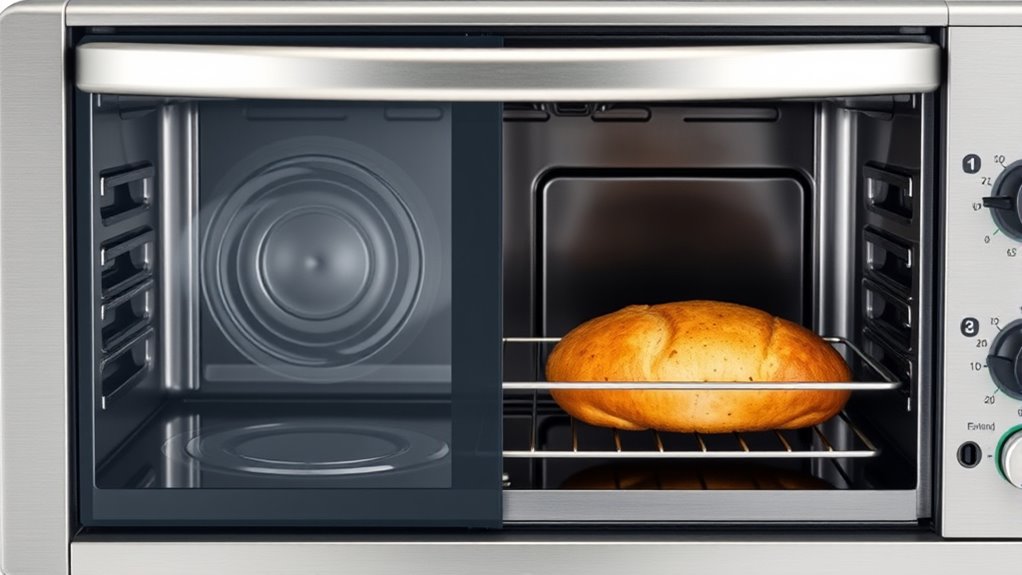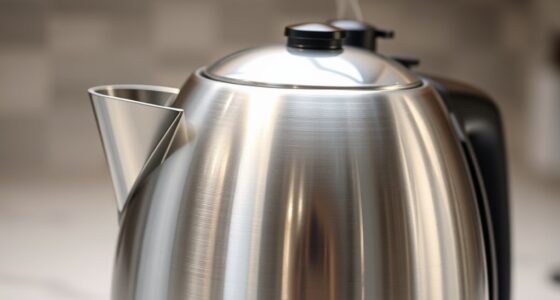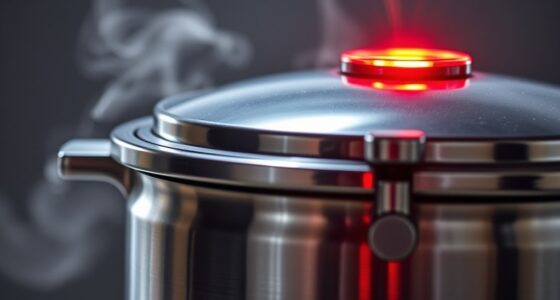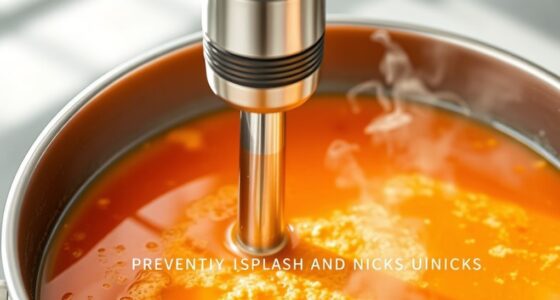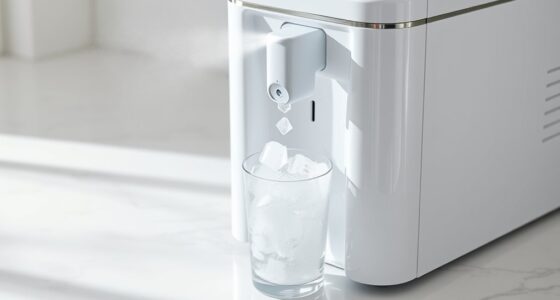If you want faster, more even cooking and crispier results, convection mode is the winner in toaster ovens. It uses a fan to circulate hot air, browning food more evenly and producing a crunchier exterior, especially for baked goods and roasted vegetables. The bake setting relies on stationary heat, which can lead to longer cooking times and uneven results. Keep exploring to discover when each mode works best for your cooking needs.
Key Takeaways
- Convection circulates hot air for faster, more even cooking, ideal for crispy and browned foods.
- Bake mode provides gentle, steady heat suitable for delicate baked goods like cakes and soufflés.
- Convection reduces cooking time and energy use due to active air circulation.
- Bake setting may result in longer cooking times and potential unevenness for dense items.
- Choice depends on food type: convection for crispiness and speed; bake for gentle, uniform heating.
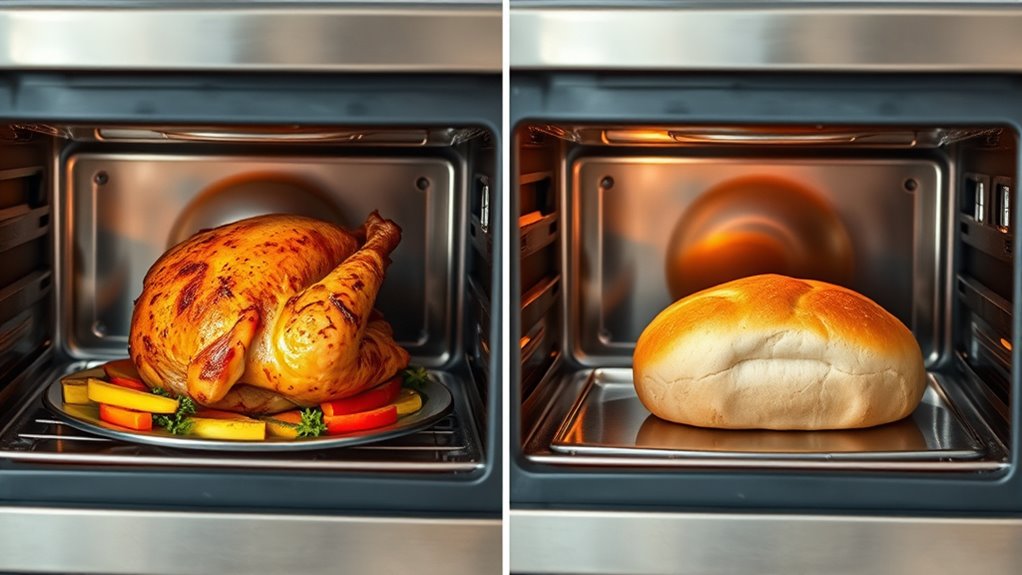
When choosing a setting for your toaster oven, understanding the difference between convection and bake modes can significantly impact your cooking results. Convection mode uses a fan to circulate hot air evenly around your food, which can lead to quicker and more uniform cooking. This enhanced air circulation ensures that heat reaches all sides of your dish simultaneously, reducing hot spots and helping baked goods, roasted vegetables, or meats cook more evenly. On the other hand, the bake setting typically relies on stationary heat from the heating elements, without the assistance of a fan. This can result in less consistent air flow and potentially uneven cooking, especially for thicker or denser items.
Energy efficiency is another vital factor when choosing between these two modes. Convection mode generally consumes less energy because it cooks food faster at lower temperatures. The efficient air circulation means you don’t need to set your oven at as high a temperature or leave it on as long, saving electricity and reducing your overall energy footprint. If you’re conscious of your energy use or want to cut down on utility bills, convection mode can be a smarter choice, especially for everyday cooking tasks. Conversely, the bake setting might require longer cooking times at higher temperatures, which can consume more energy overall. While it may be suitable for certain recipes that need gentle, even heat without the movement of air, it’s not as energy-efficient as convection.
Your choice might also depend on what you’re cooking. For instance, when baking cookies, roasting vegetables, or crisping up leftovers, convection typically delivers better results because the air circulation promotes even browning and crispiness. It’s particularly useful when you need a crispy exterior or a golden finish. In contrast, traditional bake mode might be preferred for delicate items like soufflés or cakes, where gentle, steady heat is more important than rapid, even cooking. It’s also worth considering that some recipes specify a particular mode, so following those instructions can help you achieve the best results.
Frequently Asked Questions
How Do Convection and Bake Modes Affect Cooking Time?
Convection and bake modes affect your cooking time by how they use air circulation and heat distribution. Convection, with its fan, circulates hot air evenly, usually reducing cooking time by about 25%. Bake mode relies on static heat, so it takes longer. You’ll notice that convection speeds up your cooking, making your meals ready sooner, while bake provides gentler, more traditional heat for thorough, even results.
Are Some Foods Better Suited for Convection or Bake?
Some foods are definitely better suited for convection, while others shine with bake mode. If you want food with crispier texture and quicker cooking, convection is your best bet, enhancing flavor through even heat. But for delicate baked goods like cakes or bread, the gentle heat of bake mode preserves texture and flavor. Knowing which mode to use can elevate your cooking, ensuring perfect texture and flavor every time.
Does Using Convection Save Energy Compared to Baking?
Using convection generally saves energy compared to baking because it’s more energy-efficient and speeds up cooking. The fan circulates hot air evenly, allowing you to cook at lower temperatures and for shorter times. This reduces overall energy usage, making convection a more eco-friendly choice. Plus, the faster cooking speed means you get your food ready quicker, saving you time and energy every time you use your toaster oven.
Can I Switch Between Modes During Cooking?
Yes, you can switch between modes during cooking to enhance your cooking flexibility. Most toaster ovens let you toggle between convection and bake modes easily, allowing you to adapt to different recipes or adjust for better results. Just pause your cooking, change the mode, and continue. This feature helps you customize your cooking process, ensuring your dishes turn out perfectly without needing multiple appliances.
How Does Mode Choice Impact Food Texture and Flavor?
Choosing the right mode impacts your food’s texture and flavor profoundly. Convection circulates hot air, promoting even food caramelization and a crispy exterior, while also helping moisture retention inside. Baking, on the other hand, delivers a gentler heat, which can result in softer textures and less caramelization. Your selection influences how browned or moist your dish becomes, so pick the mode that best aligns with your desired outcome.
Conclusion
So, whether you choose convection or bake mode, your toaster oven is about to become your culinary superhero. Convection, with its turbo-charged heat, can make your dishes cook faster than a race car, while bake mode delivers that classic, even warmth everyone loves. Think of it as choosing your adventure—speed or tradition. No matter what you pick, your toaster oven’s about to transform your kitchen into a gourmet battleground. Get ready to conquer your next meal!
